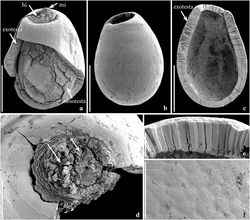Biology:Notonuphar
| Notonuphar | |
|---|---|

| |
| Fossil seeds | |
| Scientific classification | |
| Kingdom: | Plantae |
| Clade: | Tracheophytes |
| Clade: | Angiosperms |
| Order: | Nymphaeales |
| Family: | Nymphaeaceae |
| Genus: | †Notonuphar Friis, Iglesias, Reguero & Mörs, 2017 |
| Species: | †N. antarctica
|
| Binomial name | |
| †Notonuphar antarctica Friis, Iglesias, Reguero & Mörs, 2017
| |
Notonuphar is an extinct genus of water lily in the family Nymphaeaceae. It contains a single species, Notonuphar antarctica. It is only known only from the Eocene-aged La Meseta Formation of Seymour Island, Antarctica.[1]
Taxonomy
It is notable for being the first water lily known to have inhabited Antarctica. It is known from numerous fossil seeds which are abundant throughout certain horizons of the La Meseta Formation, constituting over 95% of fossil seeds in some areas. The anatomy of these seeds supports a close relationship with the genus Nuphar, a genus presently restricted to the Northern Hemisphere. Morphological analysis also recovers it as being the sister genus of Nuphar. It is the first Gondwanan plant known to be related to Nuphar.[1][2]
The genus name Notonuphar is derived from the Greek word "notos" (meaning "south") and Nuphar, literally translating to "southern Nuphar." The specific epithet antarctica refers to the species being discovered on the continent of Antarctica.[1][2]
Paleobiology
During the Eocene, Antarctica was not yet glaciated and had a climate and ecosystem similar to the modern Valdivian temperate rain forest of Chile . Notonuphar is the first discovered Antarctic fossil species known to have inhabited freshwater habitats. It was likely a common plant of freshwater wetlands near the coast. Rivers may have washed Notonuphar seeds from these wetlands into the sea, where they later fossilized. Notonuphar likely shared its freshwater habitat with an undescribed aquatic plant possibly related to Nelumbo, as well as a large, undescribed frog of the genus Calyptocephalella (which was found at the same type locality).[1][3]
See also
- Antarctic flora
References
- ↑ 1.0 1.1 1.2 1.3 Friis, Else M.; Iglesias, Ari; Reguero, Marcelo A.; Mörs, Thomas (2017-08-01). "Notonuphar antarctica, an extinct water lily (Nymphaeales) from the Eocene of Antarctica" (in en). Plant Systematics and Evolution 303 (7): 969–980. doi:10.1007/s00606-017-1422-y. ISSN 2199-6881. https://doi.org/10.1007/s00606-017-1422-y.
- ↑ 2.0 2.1 "Notonuphar E.M.Friis, A.Iglesias, Reguero et Mörs | Plant Fossil Names". https://www.plantfossilnames.org/name/2725/.
- ↑ Mörs, Thomas; Reguero, Marcelo; Vasilyan, Davit (2020-04-23). "First fossil frog from Antarctica: implications for Eocene high latitude climate conditions and Gondwanan cosmopolitanism of Australobatrachia" (in en). Scientific Reports 10 (1): 5051. doi:10.1038/s41598-020-61973-5. ISSN 2045-2322. PMID 32327670. Bibcode: 2020NatSR..10.5051M.
Wikidata ☰ Q113685750 entry
 |

